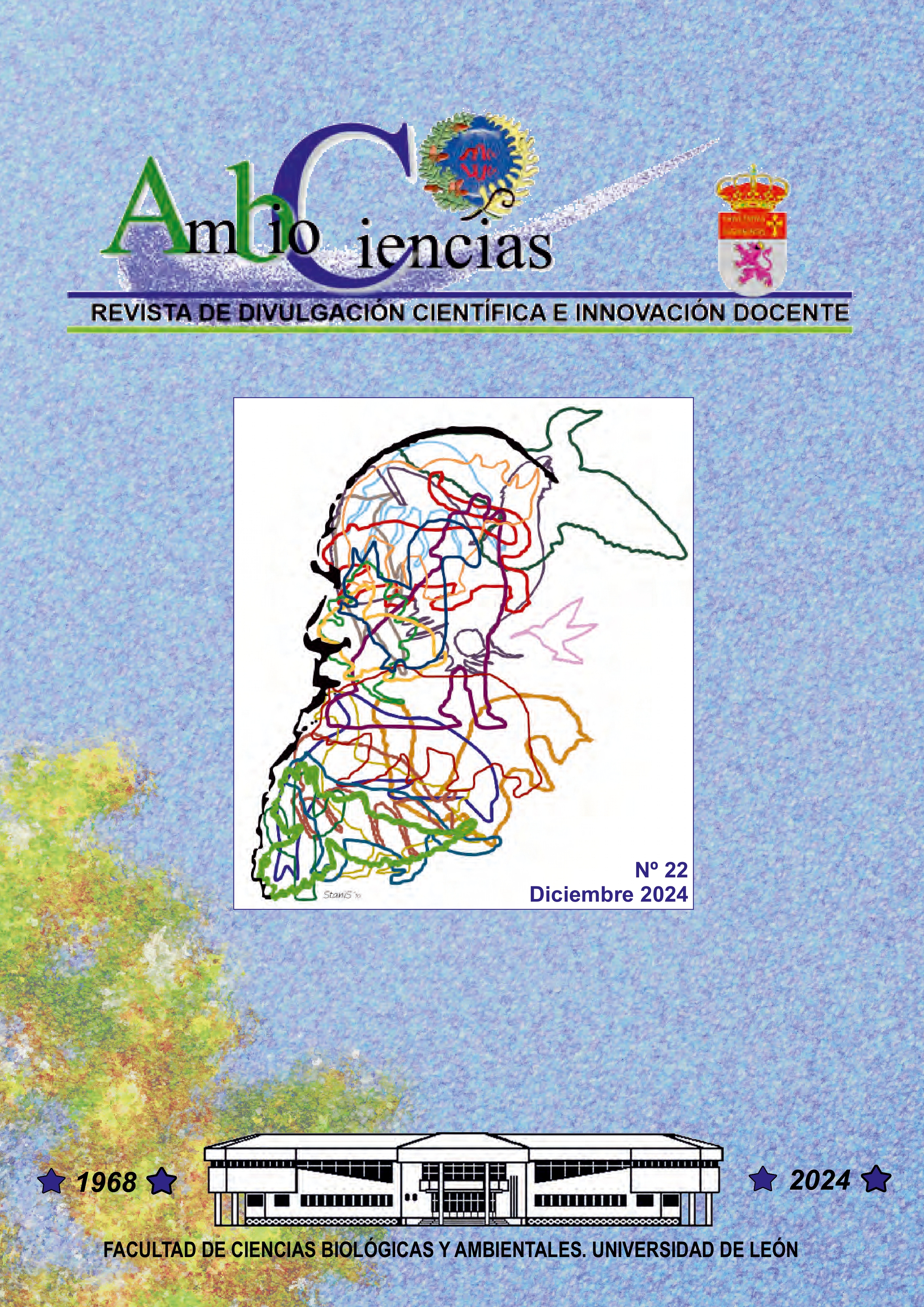Mecanismos moleculares del ejercicio físico en la enfermedad de Alzheimer
revisión sistemática
DOI:
https://doi.org/10.18002/ambioc.i22.8618Parole chiave:
Alzheimer, ejercicio físico, patología tau, placas beta-amiloidesAbstract
La enfermedad de Alzheimer (EA), una de las patologías neurodegenerativas más prevalentes a nivel global, se caracteriza por un deterioro progresivo de la memoria y las funciones cognitivas, y carece actualmente de terapias curativas. Esta revisión tuvo como objetivo investigar sistemáticamente la evidencia sobre el impacto de la actividad física en los mecanismos moleculares de la EA y su influencia en el deterioro cognitivo. De los 229 artículos obtenidos en la búsqueda, se incluyeron 8 estudios en base a los criterios de elegibilidad. Los estudios evaluaron diversos protocolos de ejercicio y su efecto en procesos clave, como la acumulación de placas beta-amiloides, la formación de ovillos neurofibrilares, la neuroinflamación, el estrés oxidativo, y las alteraciones sinápticas y mitocon- driales. A lo largo de la revisión, se examinaron las interacciones entre estas vías, ofreciendo una visión integral de los mecanismos patológicos subyacentes a la enfermedad y evidenciando que la actividad física ayuda a mitigar dichos procesos. Los resultados de esta revisión ponen de manifiesto el ejercicio como una intervención no farmacológica prometedora para ralentizar el avance de la EA.
Downloads
Riferimenti bibliografici
Brandt, R., Trushina, N. I. y Bakota, L. 2020. Much more than a cytoskeletal protein: physiological and pathological functions of the non-microtubule binding region of tau. Frontiers in Neurology, 11:590059.
Chen, M., Wang, J., Jiang, J., Zheng, X. et al. 2017. APP modulates KCC2 expression and function in hippocampal GABAergic inhibition. eLife, 6:e20142.
Clarke, J. R., Lyra e Silva, N. M., Figueiredo, C. P., Frozza, R. L. et al. 2015. Alzheimer-associated Aβ oligomers impact the central nervous system to induce peripheral metabolic deregulation. EMBO Molecular Medicine, 7(2):190-210.
Delgado-Peraza, F., Nogueras-Ortiz, C., Simonsen, A. H., Knight, D. D. A. et al. 2023. Neuron-derived extracellular vesicles in blood reveal effects of exercise in Alz- heimer’s disease. Alzheimer’s Research and Therapy, 15(1):156.
Farias, J. M. D., Santos Tramontin, N., Pereira, E. V., de Moraes, G. L. et al. 2021. Physical exercise training improves judgment and problem-solving and modulates serum biomarkers in patients with Alzheimer’s disease. Molecular Neurobiology, 58(9):4217-4225.
Griffiths, J. y Grant, S. G. N. 2023. Synapse pathology in Alzheimer’s disease. Seminars in Cell and Developmental Biology, 139:13–23.
Guo, T., Zhang, D., Zeng, Y., Huang, T. Y. et al. 2020. Molecular and cellular mechanisms underlying the pathogenesis of Alzheimer’s disease. Molecular Neurodegeneration, 15(1):40.
Haberman, A., Williamson, W. R., Epstein, D., Wang, D. et al. 2012. The synaptic vesicle SNARE neuronal synaptobrevin promotes endolysosomal degradation and pre- vents neurodegeneration. Journal of Cell Biology, 196(2):261-276.
Hao, Z., Liu, K., Zhou, L. y Chen, P. 2023. Precious but convenient means of prevention and treatment: physiological molecular mechanisms of interaction between exercise and motor factors and Alzheimer’s disease. Frontiers in Physiology, 14:1193031.
Hashiguchi, D., Campos, H. C., Wuo-Silva, R., Faber, J. et al. 2020. Resistance exercise decreases amyloid load and modulates inflammatory responses in the APP/ PS1 mouse model for Alzheimer’s disease. Journal of Alzheimer’s Disease, 73(4):1525-1539.
Heneka, M. T., Kummer, M. P. y Latz, E. 2014. Innate immune activation in neurodegenerative disease. Nature Reviews Immunology, 14(7):463-477.
Huang, W. J., Zhang, X. y Chen, W. W. 2016. Role of oxidative stress in Alzheimer’s disease (review). Biomedical Reports, 4(5):519-522.
Jack, C. R., Bennett, D. A., Blennow, K., Carrillo, M. C. et al. 2018. NIA-AA Research Framework: Toward a biological definition of Alzheimer’s disease. Alzheimer’s and Dementia, 14(4):535-562.
Jia, R. X., Liang, J. H., Xu, Y. y Wang, Y. Q. 2019. Effects of physical activity and exercise on the cognitive function of patients with Alzheimer disease: A meta-analysis. BMC Geriatrics, 19(1):181.
Kametani, F. y Hasegawa, M. 2018. Reconsideration of amyloid hypothesis and tau hypothesis in Alzheimer’s disease. Frontiers in Neuroscience, 12:25.
Khodadadi, D., Gharakhanlou, R., Naghdi, N., Salimi, M. et al. 2018. Treadmill exercise ameliorates spatial learning and memory deficits through improving the clear- ance of peripheral and central amyloid-beta levels. Neurochemical Research, 43(8):1561-1574.
Kim, E., Kim, H., Jedrychowski, M. P., Bakiasi, G. et al. 2023. Irisin reduces amyloid-β by inducing the release of neprilysin from astrocytes following downregulation of ERK-STAT3 signaling. Neuron, 111(22): 3619-3633.
Leng, F. y Edison, P. 2021. Neuroinflammation and microglial activation in Alzheimer disease: where do we go from here? Nature Reviews Neurology, 17(3):157-172.
Liang, H. y Ward, F. W. 2006. PGC-1alpha: a key regulator of energy metabolism. Advances in Physiology Education, 30(4):145-51.
Liu, T., Zhang, L., Joo, D. y Sun, S. C. 2017. NF-κB signaling in inflammation. Signal Transduction and Targeted Therapy, 2:17023.
Liu, Y., Chu, J. M. T., Yan, T., Zhang, Y. et al. 2020. Short-term resistance exercise inhibits neuroinflammation and attenuates neuropathological changes in 3xTg Alz- heimer’s disease mice. Journal of Neuroinflammation, 17(1):4.
Maphis, N., Xu, G., Kokiko-Cochran, O. N., Jiang, S. et al. 2015. Reactive microglia drive tau pathology and contribute to the spreading of pathological tau in the brain. Brain, 138(6):1738-1755.
Mijalkov, M., Volpe, G., Fernaud-Espinosa, I., DeFelipe, J. et al. 2021. Dendritic spines are lost in clusters in Alzheimer’s disease. Scientific Reports, 11(1):12350.
Mota, B. C. y Sastre, M. 2021. The role of pgc1α in alzheimer’s disease and therapeutic interventions. International Journal of Molecular Sciences, 22(11):5769.
Nagar, P., Sharma, P., Dhapola, R., Kumari, S. et al. 2023. Endoplasmic reticulum stress in Alzheimer’s disease: molecular mechanisms and therapeutic prospects. Life Sciences, 330:121983.
Nichols, E., Steinmetz, J. D., Vollset, S. E., Fukutaki, K. et al. 2022. Estimation of the global prevalence of dementia in 2019 and forecasted prevalence in 2050: an analysis for the Global Burden of Disease Study 2019. The Lancet Public Health, 7(2):e105-e125
Pigino, G., Morfini, G., Atagi, Y., Deshpande, A. et al. 2009. Disruption of fast axonal transport is a pathogenic mechanism for intraneuronal amyloid beta. Proceed- ings of the National Academy of Sciences, 106(14):5907-5912.
Sheng, Z. H. y Cai, Q. 2012. Mitochondrial transport in neurons: Impact on synaptic ho- meostasis and neurodegeneration. Nature Reviews Neuroscience, 13(2):77-93.
Siddappaji, K. K. y Gopal, S. 2021. Molecular mechanisms in Alzheimer’s disease and the impact of physical exercise with advancements in therapeutic approaches. AIMS Neuroscience, 8(3):357-389.
Sinsky, J., Pichlerova, K. y Hanes, J. 2021. Tau protein interaction partners and their roles in Alzheimer’s disease and other Tauopathies. International Journal of Molecular Sciences, 22(17): 9207.
Storck, S. E., Meister, S., Nahrath, J., Meißner, J. N. et al. 2016. Endothelial LRP1 transports amyloid-β1-42 across the blood-brain barrier. Journal of Clinical Investi- gation, 126(1):123-36.
Therriault, J., Pascoal, T. A., Lussier, F. Z., Tissot, C. et al. 2022. Biomarker modeling of Alzheimer’s disease using PET-based Braak staging. Nature Aging, 2(6):526- 535.
Tokutake, T., Kasuga, K., Yajima, R., Sekine, Y. et al. 2012. Hyperphosphorylation of tau induced by naturally secreted amyloid-β at nanomolar concentrations is modulated by insulin-dependent Akt-GSK3β signaling pathway. Journal of Biological Chemistry, 287(42): 35222-35233
Wang, X., Su, B., Lee, H. G., Li, X. et al. 2009. Impaired balance of mitochondrial fission and fusion in Alzheimer’s disease. Journal of Neuroscience, 29(28): 9090-9103.
Wrann, C. D., White, J. P., Salogiannnis, J., Laznik-Bogoslavski, D. et al. 2013. Exercise induces hippocampal BDNF through a PGC-1α/FNDC5 pathway. Cell Metabolism, 18(5):649-659.
Wu, C., Yang, L., Li, Y., Dong, Y. A. N. et al. 2020. Effects of exercise training on anxious-depressive-like behavior in Alzheimer rat. Medicine and Science in Sports and Exercise, 52(7):1456-1469
Xia, J., Li, B., Yin, L., Zhao, N. et al. 2019. Treadmill exercise decreases β-amyloid burden in APP/PS1 transgenic mice involving regulation of the unfolded protein response. Neuroscience Letters, 703: 125-131
Yang, L., Wu, C., Li, Y., Dong, Y. et al. 2022. Long-term exercise pre-training attenuates Alzheimer’s disease–related pathology in a transgenic rat model of Alzheimer’s disease. GeroScience, 44(3):1457-1477
Yang, L., Youngblood, H., Wu, C. y Zhang, Q. (2020). Mitochondria as a target for neuroprotection: role of methylene blue and photobiomodulation. Translational Neurodegeneration, 44(3):1457-1477.
Zhang, X., He, Q., Huang, T., Zhao, N. et al. 2019. Treadmill exercise decreases Aβ deposition and counteracts cognitive decline in APP/PS1 mice, possibly via hippocampal microglia modifications. Frontiers in Aging Neuroscience, 11:78.
Downloads
Pubblicato
Come citare
Fascicolo
Sezione
Licenza

Questo lavoro è fornito con la licenza Creative Commons Attribuzione - Non commerciale - Condividi allo stesso modo 4.0 Internazionale.
Los autores que publican en esta revista están de acuerdo con los siguientes términos:
- Los autores ceden de forma no exclusiva los derechos de explotación (reproducción, distribución, comunicación pública, transformación) a la Universidad de León, por lo que pueden establecer, por separado, acuerdos adicionales para la distribución no exclusiva de la versión de la obra publicada en la revista (por ejemplo, alojarlo en un repositorio institucional o publicarlo en un libro), con un reconocimiento de su publicación inicial en esta revista.
- Este trabajo se encuentra bajo la Creative Commons Attribution-NonCommercial-ShareAlike 4.0 International License. Puede consultarse desde aquí la versión informativa y el texto legal de la licencia.
- Se permite y se anima a los autores a difundir electrónicamente las versiones pre-print (versión antes de ser evaluada) y/o post-print (versión evaluada y aceptada para su publicación) de sus obras antes de su publicación, ya que favorece su circulación y difusión más temprana y con ello un posible aumento en su citación y alcance entre la comunidad académica.







